Water barriers TEPCO
Probably, it will not be too great a simplification to say that water is the basis of modern nuclear energy. It is the universal coolant of the overwhelming majority of nuclear reactors, almost equally universal refrigerant and fire-fighting liquid, and finally, water has very important neutron-physical characteristics, serving as a moderator and reflector of neutrons.
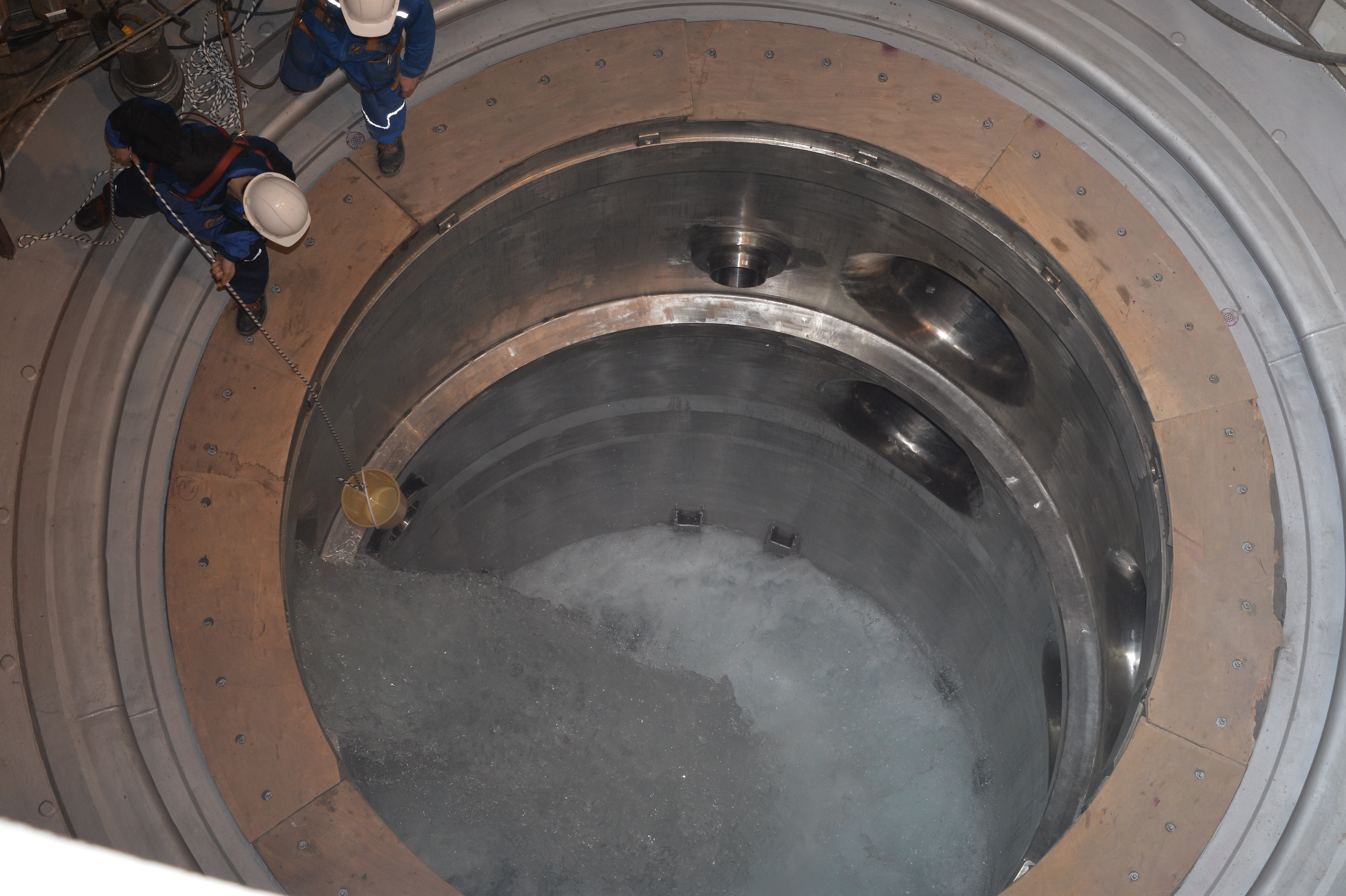
In particular, the commissioning of VVER reactors begins with “spilling water into an open reactor”; in the photo, this procedure takes place at reactor 4 of the Rostov NPP
In the case of radiation accidents, water still serves as a universal transporter of radionuclides, allowing decontamination of objects.
Today we will follow the problems arising from water in the process of liquidation of the accident at the Fukushima nuclear power plant, since this topic is tightly surrounded by mythology in the style of “polluted the whole ocean”.
On March 11, 2011, at 14.46 local time, an earthquake struck 130 kilometers off the coast of Japan, later called the “Great East Japan”, which led to one of the strongest radiation accidents at the Fukushima Daiichi NPP owned by TEPCO.

Simulated map of wave heights from the Great East Japan earthquake, commonly applied as a pollution map from the accident at the nuclear power plant
At the time of the earthquake, power units were 1,2,3, block 4 was stopped for modernization and completely unloaded from fuel in the core (AZ), and detached blocks 5.6 were under preventive maintenance, but the fuel remained in AZ. The earthquake detection system detected a seismic shock and regularly introduced emergency protection on blocks 1,2,3. However, it didn’t do without consequences - the earthquake destroyed elements of the high-voltage switchgear (open switchgear), which led to the loss of external power supply to 1,2,3,4 NPP units. The automatics of the station went on to the next line of defense - emergency diesel generators were launched, and in less than a minute the power on the tires of their own needs was restored, and the procedure for cooling down the reactors was started. The situation was tense, but more or less regular.
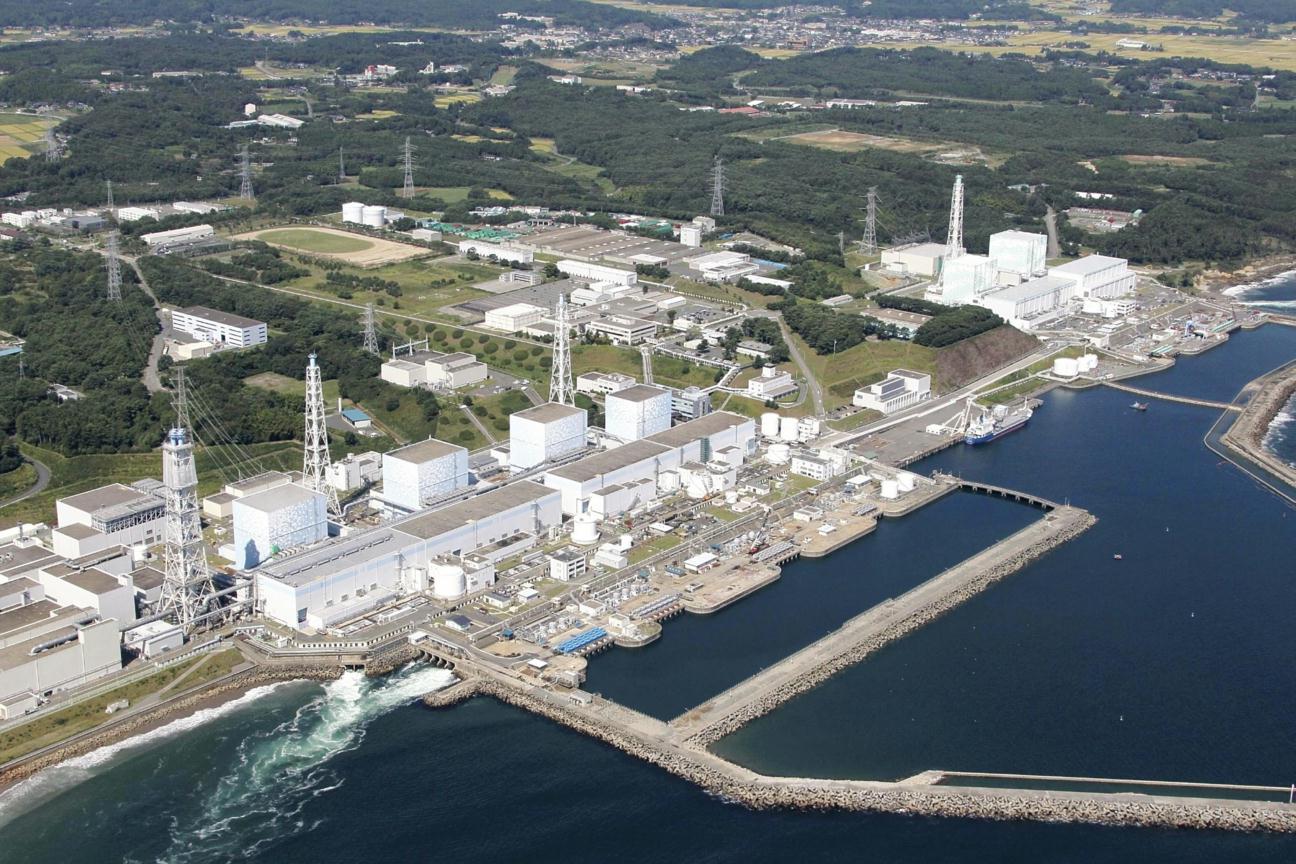
The general plan of the nuclear power plant Fukushima. Block 4 is the closest, followed by blocks 3,2,1 and in the distance - 5,6. A wall against the tsunami is visible behind the intakes of the sea cooling water, which did not help.
However, 50 minutes after the earthquake, a tsunami wave arrived at the station, flooding diesel generators and the associated electrical panels. At 15.37, there is a complete and final loss of power at the plant, causing the shutdown of reactor cooling systems, as well as the loss of sources of operational information about the state of the reactor systems.

Real shot of the bay of the nuclear power plant Fukushima Tsunami. The frame is made near the 4th block and the end of the station, the base of the ventilation pipe is seen, which serves as a guideline on the plan above.
The next few hours will pass in attempts to supply cooling water to the reactor units 1,2,3, but they will be unsuccessful. Approximately 5 hours after the loss of circulation cooling, the water inside the reactor vessels will boil below the top of the fuel assemblies. The fuel will start to overheat with the heat of residual decay and collapse. In particular, at 21.15 on the first block, background measurements will show its sharp growth, which means the release of fission products from decaying fuel. Despite further titanic efforts to fill the reactor with water (over 15 hours, 80 thousand cubic meters of water will be pumped into the lines leading to the rector of unit 1), the fuel will be completely destroyed and fused, the corium reactor will burn through the corium, hydrogen will be released as a result of the evaporation gas on 1, 2 and 3 blocks. (a detailed description of the accident is in several IAEA documents: 1 , 2 , 3 , 4 )
In the early days of the accident, the situation was somewhat similar to the development of the Chernobyl accident: desperate attempts to fill all with water had a very low efficiency due to a lack of understanding of the real situation, moreover, the water that reached the fuel residues carried the radioactive fission products, transforming the basements of the NPP in the radioactive submerged catacombs. Against the background of hydrogen explosions and the release of fairly large volumes of fission products, schemes with remote-controlled concrete pumps are used , supplying water with 70-meter arrows.

By the way, here is a photo of a concrete pump with a 70-meter jib delivered by plane from the USA for pouring blocks from above
Due to the infrastructural problems of Japan and the nuclear power plant itself, sea water with the addition of boric acid is used for the injection with might and main, this move comes around later.
The first 15 days of the accident the water at the Fukushima nuclear power plant was flooded without much understanding of where it goes then, it was important to ensure the supply of water. But on March 27, pumping out of the polluted water, flowing through the dilapidated pool-spargers of blocks 2 and 3 and the destroyed reactor vessel of block No. 1, begins. The impetus to this operation was the overexposure of electricians who were forced to work while standing in radioactive water.
In addition, it turned out that water seeps through various communications into the ocean. The IAEA estimates that in April 2011 about 10-20 PBq 131 I and 1-6 PBq of 137 Cs got into the water - 10-60 billion tons of water are needed to dilute these volumes to safe concentrations.

One of the simulations of the distribution of 137 Cs in sea water. Given the maximum permissible concentration of cesium 137 for drinking water at 100 Bq / l, you can feel the power of the ocean as a diluent
Initially, the water was pumped into various standard containers for storing active water on the territory of the NPP, but it was clear that for a long time their volumes would not be enough. The construction of additional tanks begins, and in April 2011, the development and construction of three systems for water purification from the most unpleasant radionuclides - 137 Cs, 134 Cs, 99 Tc and 131 I. began. The first system is technetium, cesium and iodine absorbers based on zeolites the US company Kurion, the second - Areva’s DI water purification system, and finally another SARRY filter absorber for cesium and iodine, built by the Japanese. The treatment system to create water circulation was built at a record pace in April-May 2011, and put into operation in June, which allowed partially closing the water circulation at the station. Why partially?
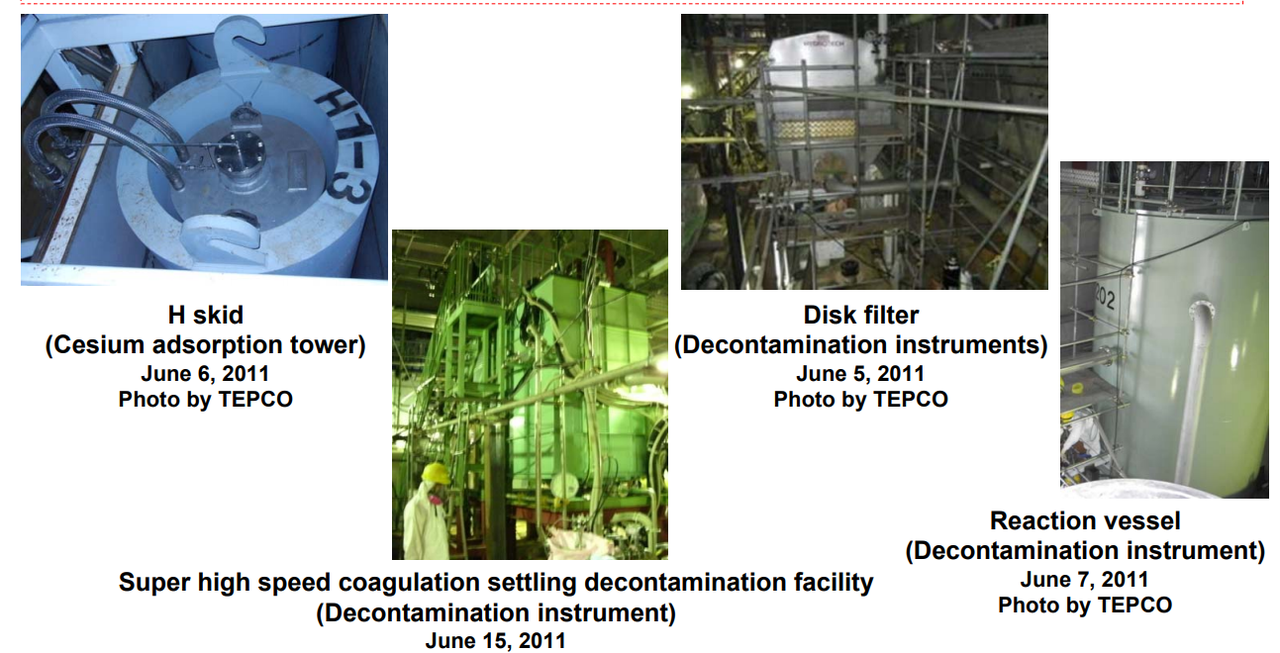
Some photos of hastily collected filter equipment
At the NPP Fukushima Daiichi, even before the accident, there was a problem of the basement inlet of underground waters. After the introduction of a closed circulation, an unpleasant moment arose that the flowing water gradually increased the total volume of radioactive water. Approximately 400 cubic meters of water per day entered the circulation system, and accordingly, every year the water grew by about 150 thousand cubic meters.
Nevertheless, it can be said that since the summer of 2011, radionuclides from the NPP site into the ocean have largely been stopped.
At that time, the Fukushima nuclear power plant turned out to be rather strange, but the working system of water circulation, spill reactors and holding pools with radioactive water, which was cleaned in a circle from only three radionuclides in an amount of about 150 thousand cubic meters per month. This made it possible to reduce the overexposure of workers, but due to the constant growth of water volumes, it gradually complicated the situation. Radioactive water with an activity of tens of megabokerkes per liter is stored in hastily constructed tanks on the territory of the nuclear power plant. This water was polluted with isotopes of strontium, ruthenium, tin, tellurium, samarium, europium - only 63 isotopes with an excess of activity standards. Filtering them all out is an incredibly difficult task, and above all it required getting rid of sea salt that got into the water at the initial stages. Therefore, already in the summer of 2011, a decision was made to build a desalting plant, and at the end of 2011 - to build an ALPS complex, purifying water from 62 isotopes at once — all of them that represent problems other than tritium.
Desalting on Hitachi and Toshiba plants using reverse osmosis on membranes and evaporators from Areva has been commissioned since late summer 2011 and gradually corrects the problems of using sea water in cooling.

Desalting plants based on reverse osmosis (top) and evaporation (bottom).
The whole 2012 is the construction of the complex ALPS. In contrast to the first constructed cleaning systems, there was no longer a big hurry, so the systems for detection and protection against leakage of radioactive water were thought out - problems that regularly torment the liquidators in different parts of the water circulation system.
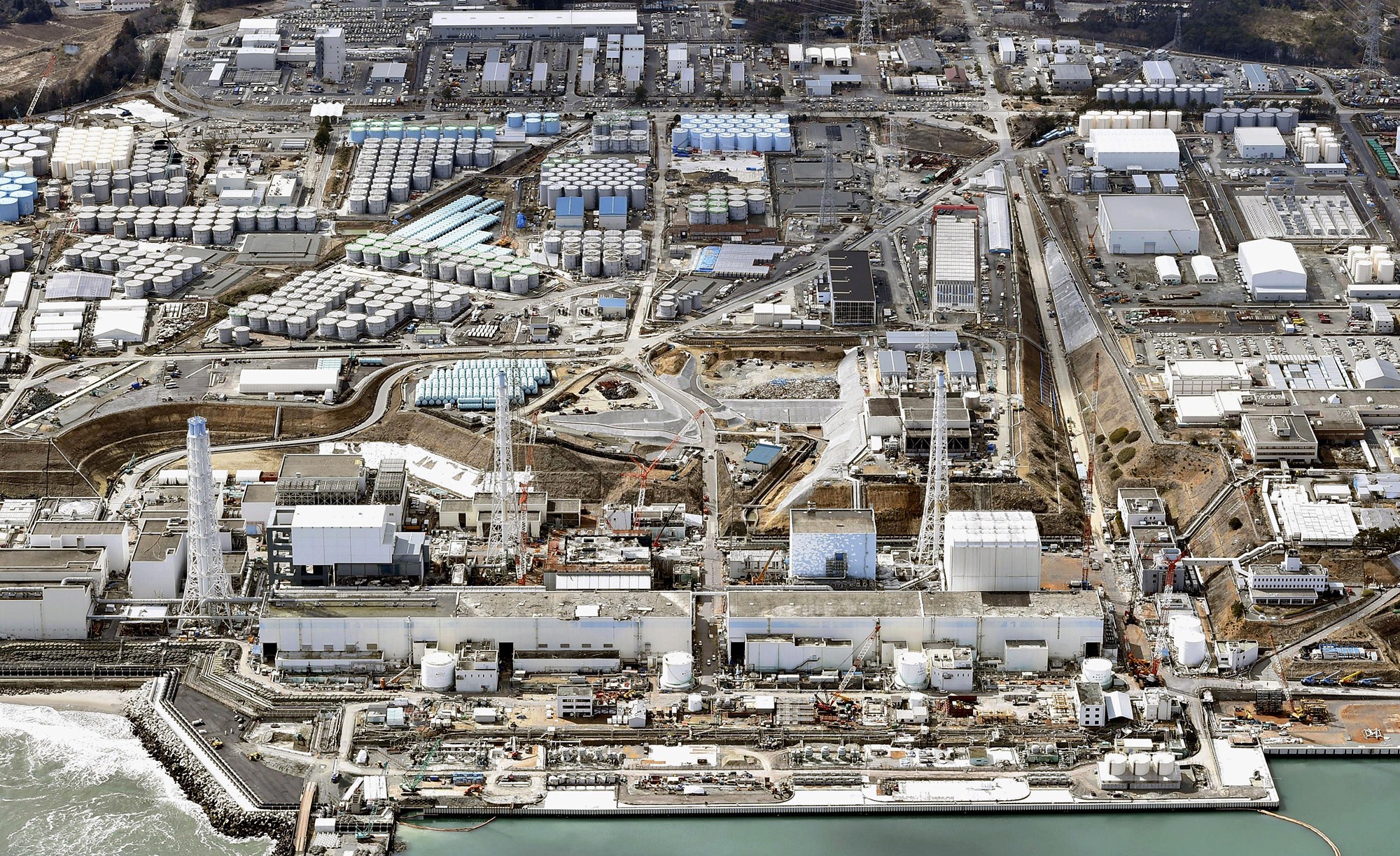
In this photo from the air of the nuclear power plant on the situation for the summer of 2013. The entire upper right corner of the frame (on a dais) is occupied by the ALPS.
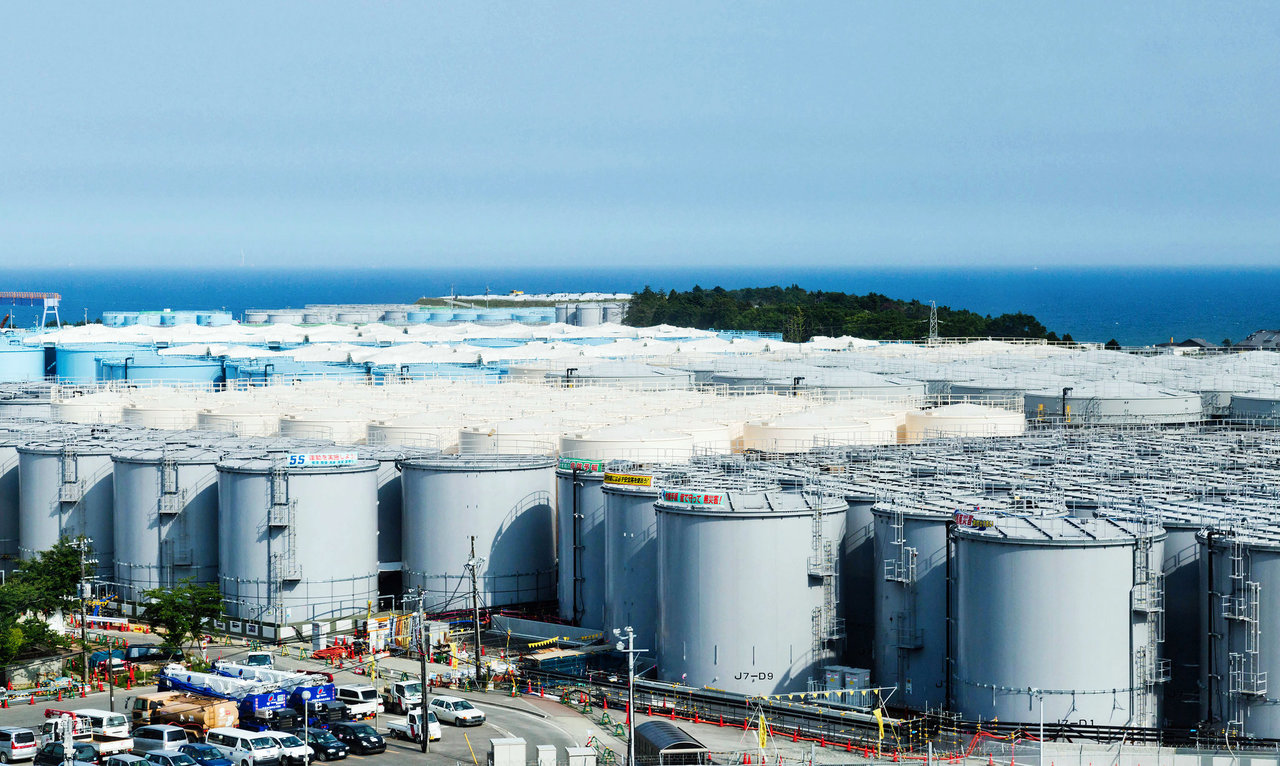
Already in 2013, an incredible number of tanks for storing radioactive water were located at the Fukushima nuclear power plant site, it is clear that leaks are inevitable here. By the way, these tanks have to be decontaminated as they are transferred to cleaner water, which required new anhydrous decontamination technologies.
In general, leaks will become not only a permanent source of emergency work, but also the subject of mythologization. A closer look at the complexity of the complex from an emergency NPP, 3 dozen water treatment plants, thousands of tanks for storing water of different quality, it is clear that leaks are a permanent condition on the site. However, the media every time serves a leak, as a serious complication of the situation.
However, apart from the minor leaks that occur every day, there were some rather unpleasant rather large incidents. The largest occurred on August 19, 2013, when a leak of 300 tons of water with an activity of ~ 80 MBq / liter from a steel tank with a capacity of 1200 cubic meters in the H4 park was discovered. Basically, this water remained in the park (tanks stand on a concrete base surrounded by a side), but several hundred liters spilled onto the ground through an open drain valve. It was radionuclides from these several hundred liters that could somehow get into the groundwater and then into the ocean (of course a very small part), which TEPCO honestly reported, but in the media's interpretation, this accident looked like “300 tons of radioactive water from the reactor flowed into the ocean ".
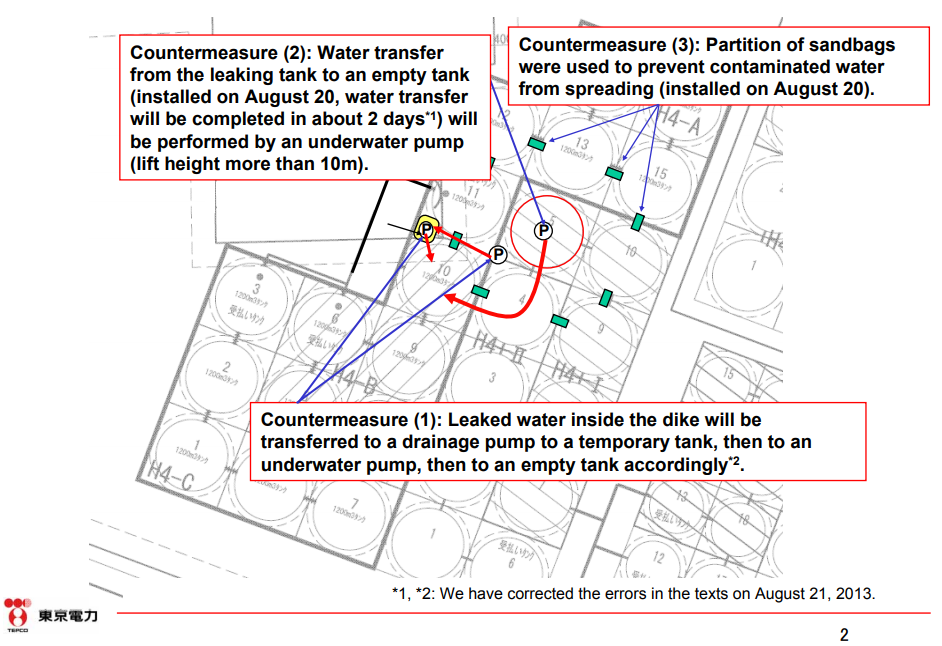
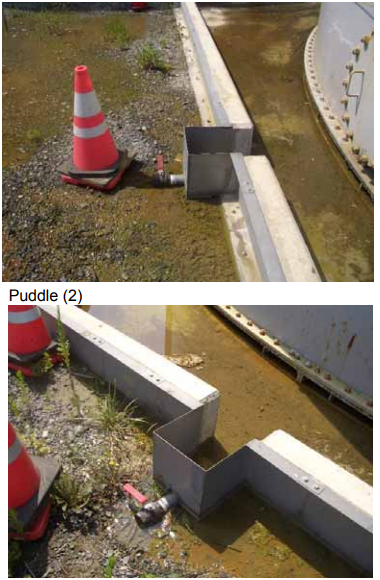
The tank from which the leak occurred (circled in red), park H4 and a photo of a puddle of radioactive water outside the concrete fencing of the park, leaked through an unopened drainage valve.
But back to the water purification. At the end of 2013, the ALPS was commissioned and the cleaning of 400,000 tons of water accumulated by that time, such as that flowing from a tank in the H4 park, began.

A very general ALPS scheme
However, as we remember, the unique installation of ALPS can do nothing with tritium, which is contained in purified water at a concentration of about 4 MBq / liter. In fact, this is not such a large value: the limit of the annual entry into the human body in Russia, for example, is limited to 0.11 GBq, i.e. 27.5 liters of such water. Taking into account that the limit of the annual income is obviously lower than any negative consequences for the organism, it can be considered that it is technical water.
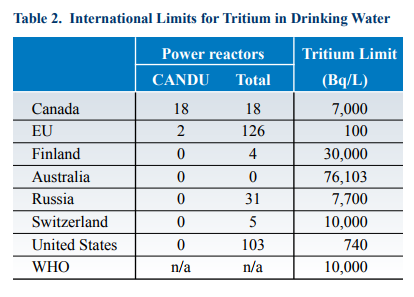
Maximum permissible tritium concentrations in drinking water. They are established according to the WHO methodology so that the exposure from such water does not exceed 5% of the natural exposure of a person. At the same time, the European Union and the United States have an alternative opinion on how to set the limits of tritium intake.
However, from the point of view of regulators, this is still low radioactive waste. In principle, TEPCO has an option in the form of a dilution 40 times (up to 100 kBq / l or less) and the descent of this water into the ocean, but against the background of media hysteria, this is difficult.
Therefore, starting in 2014, TEPCO is trying to implement two other strategies - to find a technology to extract tritium from water and minimize the influx of groundwater into nuclear power plant buildings in order to slow the growth of the total amount of stored water.
Tritium concentration technologies exist, usually a combination of electrolysis methods, isotopic exchange between water vapor and hydrogen gas on catalysts, and cryogenic distillation of hydrogen isotopes. The largest installations for extracting tritium from heavy water are located in Canada (where there are many heavy water reactors whose water must be cleaned of tritium) and Korea (where there are also heavy water reactors).

A typical installation for the separation of water isotopes is as follows (this is the Canadian AECL Glace Bay). Something is proposed to build TEPCO at the site of the Fukushima nuclear power plant.
However, ready-made technologies hardly work at such low concentrations as are at the site of the Fukushima NPP. The various proposals that were made by TEPCO (including its technology offered by the Federal State Unitary Enterprise RosRAO Rosatom) are not satisfied with the company performance against the cost of installation.
The second aspect - reduction of groundwater inflow; it was decided to carry out the construction of an “ice wall” around buildings 1–4 of NPPs with the help. The essence of the technology was the arrangement of a network of wells along the wall contour and freezing of the soil with the help of a salt coolant. The construction of the system in 2015-2016 was accompanied by an unhealthy media boom (which for some reason thought it was “the last barrier to the flow of radioactive water into the ocean”) and ended with a fail: after freezing the entire planned volume, the groundwater flow decreased by only 10 -15%.
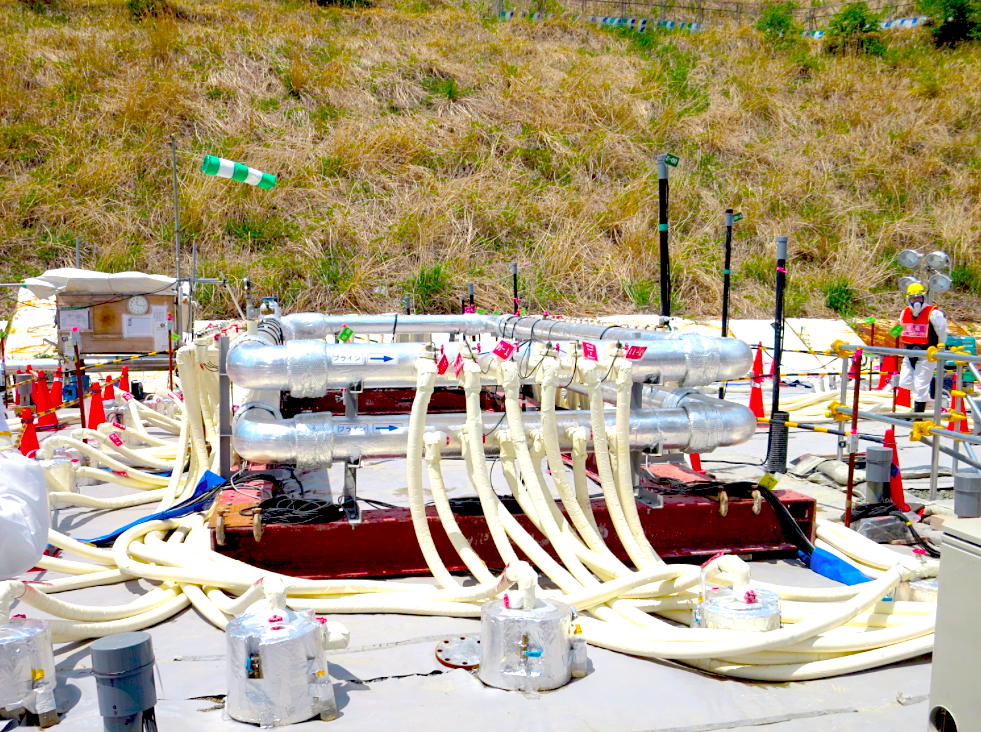
The freezing process - distributing refrigerant pipelines and wellheads.
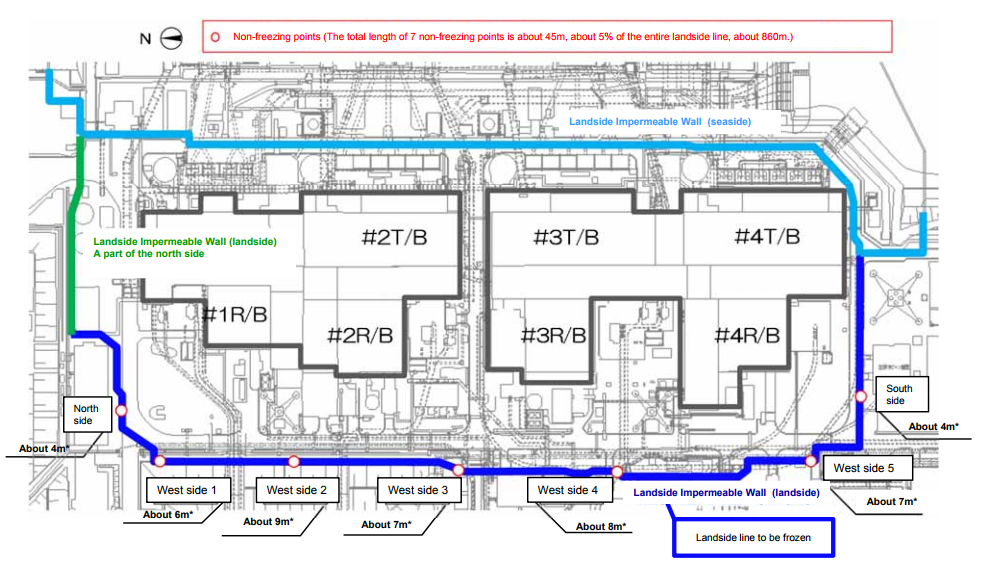
The contour of the ice wall in the spring of 2016.
As a result, the last 3 years there has been a certain stability of the situation with water - for cooling purposes, about 300 tons of clean water is pumped into NPPs per day, about 700 extracted are polluted, pre-cleaned and desalted and fed into intermediate storage of LRW, which gradually decreases, but in August 2017 is still ~ 150 thousand tons. Further, this water passes the ALPS complex and accumulates in water storage tanks with tritium, where now there are about 820 thousand tons of water. Total on the site in different containers and buffers of about 900 thousand tons of water.

General scheme of water circulation at Fukushima NPP in August 2017
An important part of this process is the accumulation of absorbents with radioactive waste and precipitation filtration, which are also stored at the Fukushima nuclear power plant in concrete containers, and whose fate sometime later also have to be decided, but this is a more trivial topic, of little interest to the media.
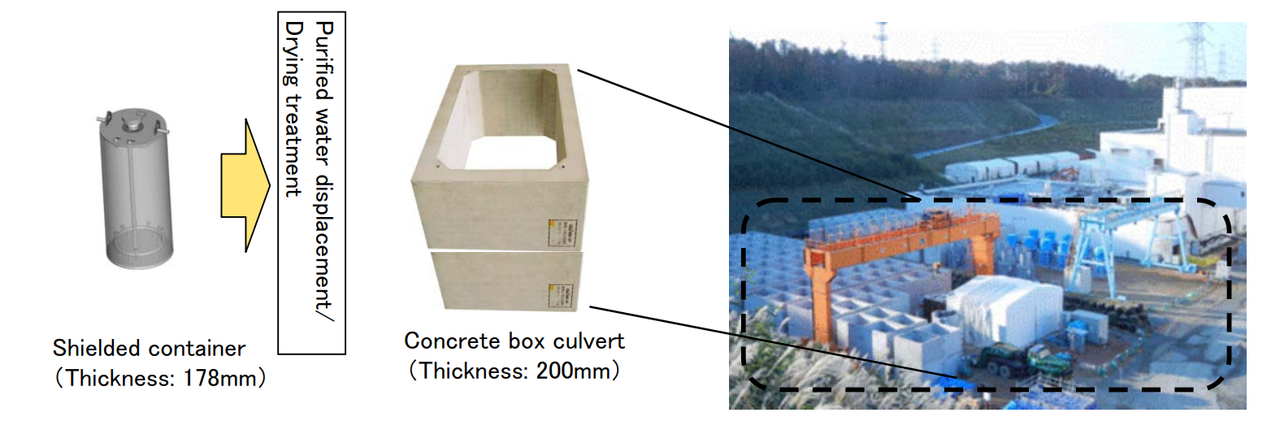
The treatment scheme with waste filtrates at water treatment plants at Fukushima NPP. Location of RW storage sites in the diagram at the end of the article.
The accumulation of water gradually leads to the exhaustion of places for the organization of storage sites for tanks, and obviously, somehow this problem will have to be solved. In 2017, TEPCO resumed probing the soil about the discharge of water from 3.4 PBq of tritium into the ocean, but something does not look like the public was ready for this. I don’t know if TEPCO’s international PR cares, or if it’s just domestic Japanese, but it’s put up at the company very badly.
Finally, I would like to say that the experience of TEPCO at the site shows that the technologies for handling HRAO are quite seriously developed today that would almost instantly organize cleaning and closure of water circulation, but on the other hand have weaknesses in the form of lack of solutions for tritium and for combating water leaks . Finally, this experience shows that investments in the right PR for the nuclear industry are no less important than investments in technology: if the media at least correctly interpreted the situation with water at the Fukushima nuclear power plant, then it would be easier to drain the water with tritium and save would tepco a few billion dollars.
PS a detailed, albeit slightly outdated, layout of objects in the liquidation zone.
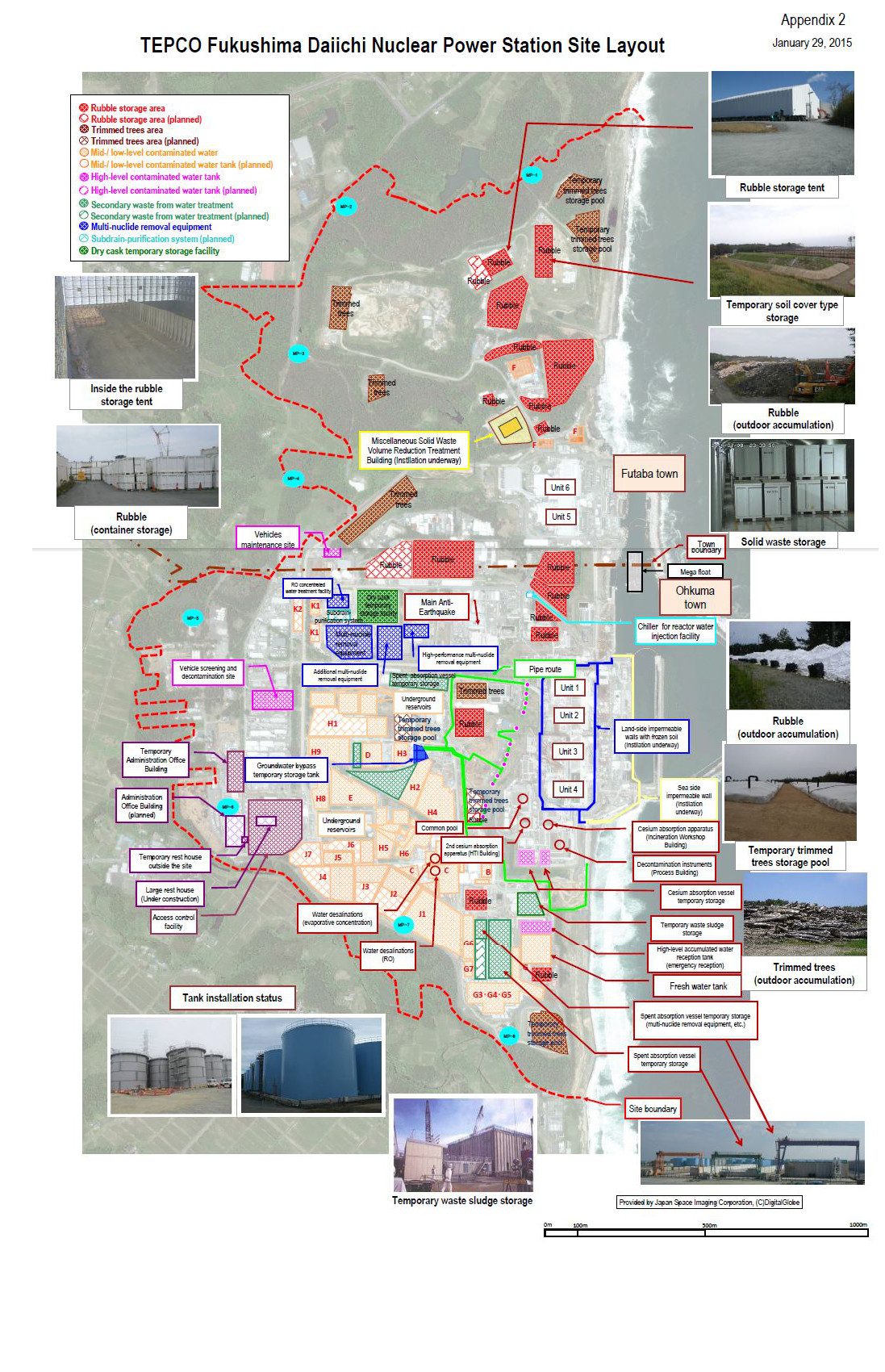

In particular, the commissioning of VVER reactors begins with “spilling water into an open reactor”; in the photo, this procedure takes place at reactor 4 of the Rostov NPP
In the case of radiation accidents, water still serves as a universal transporter of radionuclides, allowing decontamination of objects.
Today we will follow the problems arising from water in the process of liquidation of the accident at the Fukushima nuclear power plant, since this topic is tightly surrounded by mythology in the style of “polluted the whole ocean”.
On March 11, 2011, at 14.46 local time, an earthquake struck 130 kilometers off the coast of Japan, later called the “Great East Japan”, which led to one of the strongest radiation accidents at the Fukushima Daiichi NPP owned by TEPCO.

Simulated map of wave heights from the Great East Japan earthquake, commonly applied as a pollution map from the accident at the nuclear power plant
At the time of the earthquake, power units were 1,2,3, block 4 was stopped for modernization and completely unloaded from fuel in the core (AZ), and detached blocks 5.6 were under preventive maintenance, but the fuel remained in AZ. The earthquake detection system detected a seismic shock and regularly introduced emergency protection on blocks 1,2,3. However, it didn’t do without consequences - the earthquake destroyed elements of the high-voltage switchgear (open switchgear), which led to the loss of external power supply to 1,2,3,4 NPP units. The automatics of the station went on to the next line of defense - emergency diesel generators were launched, and in less than a minute the power on the tires of their own needs was restored, and the procedure for cooling down the reactors was started. The situation was tense, but more or less regular.

The general plan of the nuclear power plant Fukushima. Block 4 is the closest, followed by blocks 3,2,1 and in the distance - 5,6. A wall against the tsunami is visible behind the intakes of the sea cooling water, which did not help.
However, 50 minutes after the earthquake, a tsunami wave arrived at the station, flooding diesel generators and the associated electrical panels. At 15.37, there is a complete and final loss of power at the plant, causing the shutdown of reactor cooling systems, as well as the loss of sources of operational information about the state of the reactor systems.

Real shot of the bay of the nuclear power plant Fukushima Tsunami. The frame is made near the 4th block and the end of the station, the base of the ventilation pipe is seen, which serves as a guideline on the plan above.
The next few hours will pass in attempts to supply cooling water to the reactor units 1,2,3, but they will be unsuccessful. Approximately 5 hours after the loss of circulation cooling, the water inside the reactor vessels will boil below the top of the fuel assemblies. The fuel will start to overheat with the heat of residual decay and collapse. In particular, at 21.15 on the first block, background measurements will show its sharp growth, which means the release of fission products from decaying fuel. Despite further titanic efforts to fill the reactor with water (over 15 hours, 80 thousand cubic meters of water will be pumped into the lines leading to the rector of unit 1), the fuel will be completely destroyed and fused, the corium reactor will burn through the corium, hydrogen will be released as a result of the evaporation gas on 1, 2 and 3 blocks. (a detailed description of the accident is in several IAEA documents: 1 , 2 , 3 , 4 )
In the early days of the accident, the situation was somewhat similar to the development of the Chernobyl accident: desperate attempts to fill all with water had a very low efficiency due to a lack of understanding of the real situation, moreover, the water that reached the fuel residues carried the radioactive fission products, transforming the basements of the NPP in the radioactive submerged catacombs. Against the background of hydrogen explosions and the release of fairly large volumes of fission products, schemes with remote-controlled concrete pumps are used , supplying water with 70-meter arrows.

By the way, here is a photo of a concrete pump with a 70-meter jib delivered by plane from the USA for pouring blocks from above
Due to the infrastructural problems of Japan and the nuclear power plant itself, sea water with the addition of boric acid is used for the injection with might and main, this move comes around later.
The first 15 days of the accident the water at the Fukushima nuclear power plant was flooded without much understanding of where it goes then, it was important to ensure the supply of water. But on March 27, pumping out of the polluted water, flowing through the dilapidated pool-spargers of blocks 2 and 3 and the destroyed reactor vessel of block No. 1, begins. The impetus to this operation was the overexposure of electricians who were forced to work while standing in radioactive water.
In addition, it turned out that water seeps through various communications into the ocean. The IAEA estimates that in April 2011 about 10-20 PBq 131 I and 1-6 PBq of 137 Cs got into the water - 10-60 billion tons of water are needed to dilute these volumes to safe concentrations.

One of the simulations of the distribution of 137 Cs in sea water. Given the maximum permissible concentration of cesium 137 for drinking water at 100 Bq / l, you can feel the power of the ocean as a diluent
Initially, the water was pumped into various standard containers for storing active water on the territory of the NPP, but it was clear that for a long time their volumes would not be enough. The construction of additional tanks begins, and in April 2011, the development and construction of three systems for water purification from the most unpleasant radionuclides - 137 Cs, 134 Cs, 99 Tc and 131 I. began. The first system is technetium, cesium and iodine absorbers based on zeolites the US company Kurion, the second - Areva’s DI water purification system, and finally another SARRY filter absorber for cesium and iodine, built by the Japanese. The treatment system to create water circulation was built at a record pace in April-May 2011, and put into operation in June, which allowed partially closing the water circulation at the station. Why partially?

Some photos of hastily collected filter equipment
At the NPP Fukushima Daiichi, even before the accident, there was a problem of the basement inlet of underground waters. After the introduction of a closed circulation, an unpleasant moment arose that the flowing water gradually increased the total volume of radioactive water. Approximately 400 cubic meters of water per day entered the circulation system, and accordingly, every year the water grew by about 150 thousand cubic meters.
Nevertheless, it can be said that since the summer of 2011, radionuclides from the NPP site into the ocean have largely been stopped.
At that time, the Fukushima nuclear power plant turned out to be rather strange, but the working system of water circulation, spill reactors and holding pools with radioactive water, which was cleaned in a circle from only three radionuclides in an amount of about 150 thousand cubic meters per month. This made it possible to reduce the overexposure of workers, but due to the constant growth of water volumes, it gradually complicated the situation. Radioactive water with an activity of tens of megabokerkes per liter is stored in hastily constructed tanks on the territory of the nuclear power plant. This water was polluted with isotopes of strontium, ruthenium, tin, tellurium, samarium, europium - only 63 isotopes with an excess of activity standards. Filtering them all out is an incredibly difficult task, and above all it required getting rid of sea salt that got into the water at the initial stages. Therefore, already in the summer of 2011, a decision was made to build a desalting plant, and at the end of 2011 - to build an ALPS complex, purifying water from 62 isotopes at once — all of them that represent problems other than tritium.
Desalting on Hitachi and Toshiba plants using reverse osmosis on membranes and evaporators from Areva has been commissioned since late summer 2011 and gradually corrects the problems of using sea water in cooling.

Desalting plants based on reverse osmosis (top) and evaporation (bottom).
The whole 2012 is the construction of the complex ALPS. In contrast to the first constructed cleaning systems, there was no longer a big hurry, so the systems for detection and protection against leakage of radioactive water were thought out - problems that regularly torment the liquidators in different parts of the water circulation system.

In this photo from the air of the nuclear power plant on the situation for the summer of 2013. The entire upper right corner of the frame (on a dais) is occupied by the ALPS.

Already in 2013, an incredible number of tanks for storing radioactive water were located at the Fukushima nuclear power plant site, it is clear that leaks are inevitable here. By the way, these tanks have to be decontaminated as they are transferred to cleaner water, which required new anhydrous decontamination technologies.
In general, leaks will become not only a permanent source of emergency work, but also the subject of mythologization. A closer look at the complexity of the complex from an emergency NPP, 3 dozen water treatment plants, thousands of tanks for storing water of different quality, it is clear that leaks are a permanent condition on the site. However, the media every time serves a leak, as a serious complication of the situation.
However, apart from the minor leaks that occur every day, there were some rather unpleasant rather large incidents. The largest occurred on August 19, 2013, when a leak of 300 tons of water with an activity of ~ 80 MBq / liter from a steel tank with a capacity of 1200 cubic meters in the H4 park was discovered. Basically, this water remained in the park (tanks stand on a concrete base surrounded by a side), but several hundred liters spilled onto the ground through an open drain valve. It was radionuclides from these several hundred liters that could somehow get into the groundwater and then into the ocean (of course a very small part), which TEPCO honestly reported, but in the media's interpretation, this accident looked like “300 tons of radioactive water from the reactor flowed into the ocean ".


The tank from which the leak occurred (circled in red), park H4 and a photo of a puddle of radioactive water outside the concrete fencing of the park, leaked through an unopened drainage valve.
But back to the water purification. At the end of 2013, the ALPS was commissioned and the cleaning of 400,000 tons of water accumulated by that time, such as that flowing from a tank in the H4 park, began.

A very general ALPS scheme
However, as we remember, the unique installation of ALPS can do nothing with tritium, which is contained in purified water at a concentration of about 4 MBq / liter. In fact, this is not such a large value: the limit of the annual entry into the human body in Russia, for example, is limited to 0.11 GBq, i.e. 27.5 liters of such water. Taking into account that the limit of the annual income is obviously lower than any negative consequences for the organism, it can be considered that it is technical water.

Maximum permissible tritium concentrations in drinking water. They are established according to the WHO methodology so that the exposure from such water does not exceed 5% of the natural exposure of a person. At the same time, the European Union and the United States have an alternative opinion on how to set the limits of tritium intake.
However, from the point of view of regulators, this is still low radioactive waste. In principle, TEPCO has an option in the form of a dilution 40 times (up to 100 kBq / l or less) and the descent of this water into the ocean, but against the background of media hysteria, this is difficult.
Therefore, starting in 2014, TEPCO is trying to implement two other strategies - to find a technology to extract tritium from water and minimize the influx of groundwater into nuclear power plant buildings in order to slow the growth of the total amount of stored water.
Tritium concentration technologies exist, usually a combination of electrolysis methods, isotopic exchange between water vapor and hydrogen gas on catalysts, and cryogenic distillation of hydrogen isotopes. The largest installations for extracting tritium from heavy water are located in Canada (where there are many heavy water reactors whose water must be cleaned of tritium) and Korea (where there are also heavy water reactors).

A typical installation for the separation of water isotopes is as follows (this is the Canadian AECL Glace Bay). Something is proposed to build TEPCO at the site of the Fukushima nuclear power plant.
However, ready-made technologies hardly work at such low concentrations as are at the site of the Fukushima NPP. The various proposals that were made by TEPCO (including its technology offered by the Federal State Unitary Enterprise RosRAO Rosatom) are not satisfied with the company performance against the cost of installation.
The second aspect - reduction of groundwater inflow; it was decided to carry out the construction of an “ice wall” around buildings 1–4 of NPPs with the help. The essence of the technology was the arrangement of a network of wells along the wall contour and freezing of the soil with the help of a salt coolant. The construction of the system in 2015-2016 was accompanied by an unhealthy media boom (which for some reason thought it was “the last barrier to the flow of radioactive water into the ocean”) and ended with a fail: after freezing the entire planned volume, the groundwater flow decreased by only 10 -15%.

The freezing process - distributing refrigerant pipelines and wellheads.

The contour of the ice wall in the spring of 2016.
As a result, the last 3 years there has been a certain stability of the situation with water - for cooling purposes, about 300 tons of clean water is pumped into NPPs per day, about 700 extracted are polluted, pre-cleaned and desalted and fed into intermediate storage of LRW, which gradually decreases, but in August 2017 is still ~ 150 thousand tons. Further, this water passes the ALPS complex and accumulates in water storage tanks with tritium, where now there are about 820 thousand tons of water. Total on the site in different containers and buffers of about 900 thousand tons of water.

General scheme of water circulation at Fukushima NPP in August 2017
An important part of this process is the accumulation of absorbents with radioactive waste and precipitation filtration, which are also stored at the Fukushima nuclear power plant in concrete containers, and whose fate sometime later also have to be decided, but this is a more trivial topic, of little interest to the media.

The treatment scheme with waste filtrates at water treatment plants at Fukushima NPP. Location of RW storage sites in the diagram at the end of the article.
The accumulation of water gradually leads to the exhaustion of places for the organization of storage sites for tanks, and obviously, somehow this problem will have to be solved. In 2017, TEPCO resumed probing the soil about the discharge of water from 3.4 PBq of tritium into the ocean, but something does not look like the public was ready for this. I don’t know if TEPCO’s international PR cares, or if it’s just domestic Japanese, but it’s put up at the company very badly.
Finally, I would like to say that the experience of TEPCO at the site shows that the technologies for handling HRAO are quite seriously developed today that would almost instantly organize cleaning and closure of water circulation, but on the other hand have weaknesses in the form of lack of solutions for tritium and for combating water leaks . Finally, this experience shows that investments in the right PR for the nuclear industry are no less important than investments in technology: if the media at least correctly interpreted the situation with water at the Fukushima nuclear power plant, then it would be easier to drain the water with tritium and save would tepco a few billion dollars.
PS a detailed, albeit slightly outdated, layout of objects in the liquidation zone.

All Articles